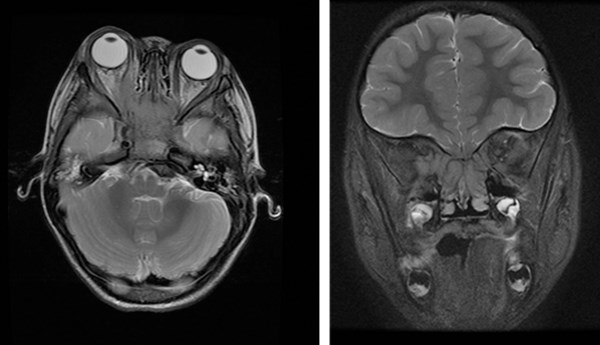Ocular swelling in children is a common complaint. But that doesn't mean the etiology is always common - or benign.
Case
A 3-year-old African-American boy with autism spectrum disorder and global developmental delay presents to the ED with right “eye swelling” for 1 week. Review of systems is negative. Vitals are age appropriate. Parents attribute his fussiness to pain on manipulation of his right eye. Examination, though limited, is significant for swelling of the right periorbital region, in the absence of erythema or discharge. It is not possible to assess pain with extraocular movements. The rest of his examination is unremarkable. Basic laboratory workup including CBC and CRP are unremarkable. Ophthalmology is consulted. Despite a limited examination, the suspicion for orbital cellulitis is low. Antibiotic treatment for presumed preseptal cellulitis is recommended. No imaging is recommended at this point, and he is discharged home on oral antibiotics.
Patient returns the following week for progressive worsening of the swelling. Vitals are unremarkable. Examination is significant for right eye proptosis, chemosis, periorbital edema and restricted eye opening without skin changes. The rest of his examination is unremarkable. CBC shows a normal white count of 5500/mm3 with no abnormal (blasts/band) cells in the peripheral smear with elevated LDH and uric acid.
The posterior pole is not visualized on ophthalmologic evaluation under sedation. Emergent MRI of the brain and orbits reveals an intracranial expansive, erosive mass within the sphenoid body with local extension into right orbital apex and its musculature. Signal characteristics of the mass (low T1 and T2 with significant diffusion restriction) and extension into the orbital musculature are highly suggestive of the tumor’s lymphoid nature. (Images 1, 2).
Discussion
PET scan demonstrates sphenoid body mass, renal, hepatic lesions and appendicular skeletal lesions with focal FDG (fluorodeoxyglucose) uptake. Endoscopic nasal biopsy confirms Burkitt’s lymphoma. Given the large tumor burden with multi organ system involvement, this patient is classified as stage III, high risk lymphoma.He is started on chemotherapy and responds well.
Ocular swelling (“eye swelling”) in children is a common complaint. Based on etiology and pathogenesis, they can be categorized as primary or secondary. Primary swellings arise from the globe and its orbital appendages including the orbit. Secondary swellings are ocular manifestations of a disease process originating elsewhere in the body (metastatic tumors, nephrotic syndrome etc.), see Table 1.

Burkitt’s lymphoma (BL) is a rare and highly aggressive small B-cell non-Hodgkin lymphoma (NHL). It mainly involves tumors of the jaw or other facial bones. It can also affect the gastrointestinal tract, ovaries, breasts and the central nervous system. Orbital involvement is rare; usually involves extraocular muscles and adjacent paranasal sinuses with a predilection for medial and inferior rectus.
Key Teaching Points
- Know how to differentiate an orbital from a periorbital swelling. Clinical clues like proptosis, asymmetrical or restricted eye movements, pupillary abnormalities, decreased visual acuity and/or inability to visualize the fundus - are indicative of orbital pathology and warrant urgent evaluation.
- Consider imaging in any orbital swelling with a high index of suspicion for malignancy on clinical examination, if accompanied with systemic illness or with inadequate antibiotic response.
- Reassurance, distraction, anxiolysis and pain control are essential before performing a comprehensive ocular examination in children, especially in younger children and children with neuro-developmental issues.
- Procedural sedation is an important tool in obtaining a comprehensive examination and should be considered early on in children.



